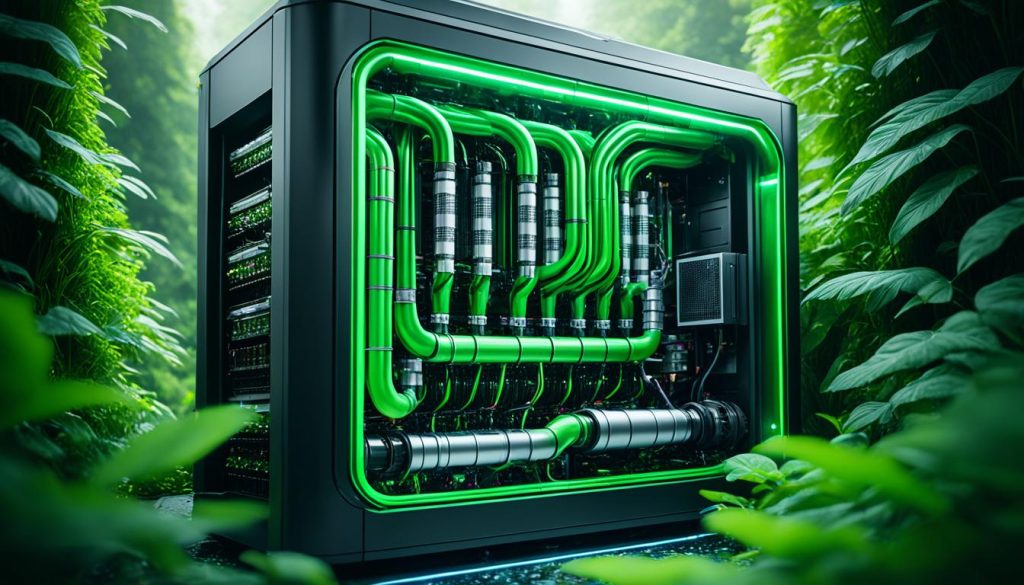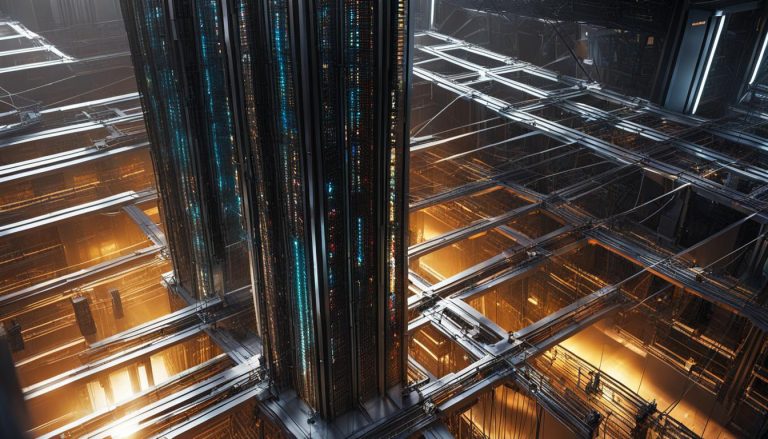As the demand for AI servers continues to rise, the need for efficient cooling solutions becomes imperative. High-performance AI workloads, with their increased power consumption, can lead to overheating and hinder performance. This is where liquid cooling systems come into play.
Liquid cooling is an essential technology for maintaining the efficiency, performance, and reliability of AI servers. By using liquid coolant, heat can be efficiently removed from the components inside the server, ensuring optimal performance and preventing overheating.
Key Takeaways:
- Liquid cooling systems are crucial for maintaining the efficiency and performance of high-performance AI servers
- By using liquid coolant, heat can be efficiently removed from the components, preventing overheating
- Dell Technologies’ Smart Cooling technology, including Direct Liquid Cooling (DLC), offers numerous benefits
- Liquid cooling enables greater computational density, uniform cooling, improved server performance, energy savings, increased sustainability, and noise reduction
- The adoption of liquid cooling systems is essential for optimizing the performance and reliability of AI infrastructure
The Challenges of Data Center Cooling in the AI Era
The rise of AI has brought about an unprecedented revolution in various industries, transforming the way organizations function and paving the way for exciting technological advancements. However, this AI revolution also brings with it a unique set of challenges for data center cooling. The power consumption of CPUs and GPUs used in AI workloads has skyrocketed, resulting in higher heat generation, and traditional air cooling methods are struggling to keep up with the increasing demands.
The cooling challenges posed by AI workloads are primarily driven by the extraordinary heat generated by CPUs and GPUs. As AI applications become more complex and demanding, the temperature of these components continues to rise, pushing the limits of traditional cooling systems. The data centers housing these high-performance AI servers must find innovative ways to dissipate the excessive heat efficiently, ensuring optimal performance and preventing the risk of overheating.
Data Center Cooling Challenges:
- Inadequate cooling capacity to address the high power consumption of AI workloads
- Difficulty in handling the increasingly intense heat generated by CPUs and GPUs
- Challenges in maintaining the temperature at optimal levels for peak performance
- Uneven heat distribution leading to potential hot spots and performance degradation
Fortunately, liquid cooling solutions have emerged as a promising answer to these cooling challenges. Liquid cooling, such as Dell Technologies’ Direct Liquid Cooling (DLC) technology, offers an efficient and effective way to tackle the heat generated by high-performance AI servers.
“Liquid cooling solutions, such as Direct Liquid Cooling (DLC), have emerged as efficient ways to address the cooling challenges associated with high-performance AI servers.”
By utilizing liquid coolant, liquid cooling systems are capable of handling the increased heat dissipation requirements. Liquid coolant is circulated around the server’s components, effectively extracting the heat and maintaining optimal temperatures for peak performance. Direct contact between specially designed liquid-cooled cold plates and the CPUs and GPUs ensures efficient heat transfer.
The Advantages of Liquid Cooling Solutions:
- Significantly higher cooling efficiency compared to traditional air cooling methods
- Ability to handle the intense heat generated by high-performance AI workload
- Improved heat distribution, minimizing the risk of hot spots and performance degradation
- Enhanced reliability, ensuring consistent performance and minimizing downtime
- Energy savings and reduced power consumption due to more efficient cooling
Implementing liquid cooling solutions, such as Dell Technologies’ DLC-enabled platforms, offer a powerful and effective way to address the cooling challenges faced by data centers in the AI era. By adopting liquid cooling technology, data centers can optimize their cooling systems to deliver the necessary performance and reliability for high-performance AI workloads.
Next, we will explore the basics of liquid cooling and how Dell’s Direct Liquid Cooling (DLC) technology addresses the cooling challenges faced by AI servers.
Understanding Liquid Cooling Basics
Liquid cooling is a thermal extraction method that utilizes liquid coolant to remove heat from the components inside a server. It offers several advantages over traditional air cooling methods, making it an ideal solution for high-performance AI servers. Dell’s Direct Liquid Cooling (DLC) technology is a cutting-edge liquid cooling solution that ensures efficient heat transfer and optimal server performance.
At the heart of Dell’s DLC technology is the coolant distribution unit (CDU). The CDU circulates liquid around a coolant loop, collecting heat from the server components and carrying it away. This closed-loop system prevents heat buildup and allows for continuous cooling.
To facilitate the heat transfer process, Dell incorporates liquid-cooled cold plates into their DLC-enabled servers. These specially designed plates make direct contact with the CPUs and GPUs, effectively dissipating heat from these high-power components. This direct contact ensures efficient heat removal, preventing overheating and maintaining server reliability.

For the heat collected by the liquid coolant to be effectively dissipated, a heat exchanger is employed. Dell’s DLC technology utilizes facility-chilled water for heat exchange, ensuring the heat is efficiently transferred out of the data center environment. This process not only keeps the servers cool but also helps maintain the overall temperature within the data center, preventing hot spots and maintaining optimal operating conditions.
Dell’s Direct Liquid Cooling Architecture
“Dell’s DLC technology integrates seamlessly with existing data center infrastructure. The CDU, cold plates, and heat exchanger work together to create a comprehensive and efficient liquid cooling system. This architecture allows for greater computational density, uniform cooling, improved server performance, and reduces energy consumption, making it an ideal solution for AI workloads.”
| Key Components | Benefits |
|---|---|
| Coolant Distribution Unit (CDU) | Ensures efficient liquid circulation and heat removal |
| Liquid-Cooled Cold Plates | Directly contacts CPUs and GPUs for optimal heat dissipation |
| Heat Exchanger | Facility-chilled water enables efficient heat exchange and dissipation |
Benefits of Direct Liquid Cooling for AI Servers
Direct Liquid Cooling (DLC) offers several advantages over traditional air-cooling methods. With DLC, data centers can achieve higher computational density, resulting in increased server capacity within a limited space. By eliminating the need for complex airflow design, DLC enables the deployment of more servers per rack, maximizing the utilization of available resources. Computational density is significantly improved through liquid cooling, allowing data centers to support the growing demands of AI workloads.
In addition to computational density, DLC provides uniform cooling across servers. Unlike air-cooling methods that can create hot spots, liquid cooling ensures that heat is evenly distributed, minimizing temperature variations and improving overall server performance. Uniform cooling is essential for maintaining stable and reliable operation, reducing the risk of performance degradation or system failures.
One of the key benefits of DLC is its ability to reduce energy consumption and deliver significant energy savings. By directly cooling the server components, liquid cooling eliminates inefficiencies associated with air-cooling methods, such as fan operation and thermal resistance. This results in reduced power consumption, lower operational costs, and a more sustainable data center environment. Energy savings are crucial in today’s data centers, where energy efficiency is a top priority for businesses seeking to optimize their operational expenses and reduce their environmental impact.
Furthermore, DLC contributes to sustainability efforts in the data center industry. As an energy-efficient cooling solution, liquid cooling aligns with the growing demand for environmentally friendly infrastructure. By reducing overall power consumption, DLC helps minimize carbon emissions and supports organizations in achieving their sustainability goals. The adoption of liquid cooling technologies, like DLC, can enhance the long-term environmental sustainability of data centers, serving as a valuable tool in combating climate change.
Lastly, DLC provides a noise reduction benefit to data center environments. Compared to air-cooling methods that rely on fans, liquid cooling systems operate silently, significantly reducing ambient noise levels. This benefit is particularly important in environments where noise pollution can impact productivity and the overall user experience.

Benefits of Direct Liquid Cooling for AI Servers:
| Advantages | Description |
|---|---|
| Computational density | Enables higher server capacity per rack, supporting the demands of AI workloads |
| Uniform cooling | Ensures even distribution of cooling, eliminating hot spots and optimizing server performance |
| Energy savings | Reduces power consumption, resulting in lower operational costs and improved energy efficiency |
| Sustainability | Contributes to environmental sustainability by minimizing carbon emissions and supporting sustainability goals |
| Noise reduction | Operates silently, reducing ambient noise levels in the data center environment |
Dell’s Liquid Cooling Solutions for AI Servers
Dell Technologies offers a range of liquid cooling solutions for AI servers. They provide DLC-enabled platforms across their server lineup, allowing customers to choose DLC-enabled servers that lower cooling costs and free up more power for compute. Dell’s DLC3000 and DLC7000 solutions incorporate liquid cooling technology, ensuring efficient heat dissipation for high-performance AI servers. The pre-integrated rack solution simplifies the installation process and includes the necessary components for liquid cooling. Dell’s OpenManage Enterprise Power Manager allows customers to monitor and manage server power and thermal data, optimizing the cooling system.
With Dell’s DLC-enabled platforms, customers can benefit from enhanced cooling efficiency, lower energy consumption, and improved server performance. The DLC3000 and DLC7000 solutions are specifically designed to address the cooling challenges associated with high-performance AI servers, offering reliable and effective heat dissipation.
Benefits of Dell’s Liquid Cooling Solutions
By utilizing Dell’s DLC-enabled platforms, organizations can experience numerous benefits:
- Lower cooling costs: Liquid cooling technology is more efficient than traditional air cooling methods, resulting in reduced cooling expenses.
- Increased compute power: DLC-enabled servers free up additional power for compute-intensive workloads, allowing organizations to maximize their AI processing capabilities.
- Improved server performance: Efficient heat dissipation through liquid cooling ensures optimal server performance, avoiding performance degradation caused by excessive heat.
- Simplified installation: Dell’s pre-integrated rack solution simplifies the setup process, providing customers with a hassle-free experience.
- Effective thermal management: OpenManage Enterprise Power Manager allows customers to monitor and manage server power and thermal data, optimizing the cooling system for maximum efficiency.
Dell’s Liquid Cooling Solutions Comparison
Compare Dell’s DLC3000 and DLC7000 solutions to understand their unique features and benefits:
| Features | DLC3000 | DLC7000 |
|---|---|---|
| Cooling Efficiency | Efficient heat dissipation for high-performance AI servers | Optimized cooling performance with enhanced computational density |
| Installation | Pre-integrated rack solution for easy setup | Pre-integrated rack solution for easy setup |
| Management | OpenManage Enterprise Power Manager for server power and thermal data monitoring | OpenManage Enterprise Power Manager for server power and thermal data monitoring |
Dell’s liquid cooling solutions offer organizations the flexibility and efficiency they need to optimize their AI server performance. With reliable cooling, simplified installation, and effective thermal management, Dell enables organizations to harness the full potential of their AI infrastructure.
The Future of Liquid Cooling in Data Centers
Liquid cooling technologies, including immersion cooling, are anticipated to have a significant impact on the data center industry as the demand for AI and high-performance computing continues to grow. These innovative cooling solutions offer a more efficient alternative to traditional air cooling methods, providing improved energy efficiency and sustainability for data centers.
Liquid cooling technologies have proven to be highly effective in addressing the cooling challenges posed by AI workloads, particularly in cooling hot spots. By directly contacting the components, such as CPUs and GPUs, liquid cooling dissipates heat more efficiently, resulting in enhanced energy efficiency and overall system performance.
Implementing liquid cooling systems may involve certain challenges, such as upfront investment and maintenance requirements. However, the environmental benefits they offer are substantial. Compared to air cooling, liquid cooling requires less energy and water, making it a more sustainable option for data centers.
The Advantages of Liquid Cooling Technologies
Liquid cooling technologies offer several advantages over conventional air cooling methods:
- Improved Energy Efficiency: Liquid cooling eliminates hot spots and distributes cooling more uniformly, leading to improved energy efficiency in data centers.
- Reduced Environmental Impact: Liquid cooling requires less energy and water compared to air cooling, resulting in a lower carbon footprint and reduced water consumption.
- Enhanced Performance: Efficient heat dissipation through liquid cooling allows for better performance and higher computational density in AI servers.
- Noise Reduction: Liquid cooling systems are quieter compared to traditional air cooling, creating a more comfortable and productive working environment.
As data centers strive to become more sustainable and energy-efficient, the adoption of liquid cooling technologies is poised to play a vital role in shaping the future of data center cooling infrastructure.
The Role of Immersion Cooling
One of the promising liquid cooling technologies gaining traction in the industry is immersion cooling. This technique involves fully submerging IT components, such as servers and storage systems, into a non-conductive cooling fluid.
Immersion cooling offers significant advantages, including increased efficiency, reduced power consumption, and the ability to accommodate higher power densities. By immersing the components in a dielectric fluid, heat is dissipated more effectively, resulting in improved overall energy efficiency.
Moreover, immersion cooling reduces the complexity associated with air cooling, eliminating the need for extensive air conditioning infrastructure. It also enables data centers to optimize space utilization by accommodating more servers within the same footprint.
The Evolving Landscape of Liquid Cooling Technologies
As the demand for AI and high-performance computing continues to increase, so does the need for advanced liquid cooling technologies. Innovations in this space are focused on enhancing energy efficiency, improving system performance, and reducing the environmental impact of data centers.
In addition to immersion cooling, other liquid cooling technologies, such as direct liquid cooling (DLC) and liquid-cooled cold plates, are being adopted to address the unique cooling requirements of high-performance computing environments.
The future of liquid cooling in data centers holds great promise not only in optimizing energy efficiency and performance but also in minimizing the environmental footprint of data center operations.
| Liquid Cooling Technologies | Advantages |
|---|---|
| Immersion Cooling |
|
| Direct Liquid Cooling (DLC) |
|
| Liquid-Cooled Cold Plates |
|
Conclusion
Liquid cooling is a crucial element in optimizing the performance and reliability of high-performance AI servers. With the increasing power demands of AI workloads, traditional air cooling methods are no longer sufficient to handle the heat dissipation. Liquid cooling offers a multitude of advantages, including greater computational density, uniform cooling, improved server performance, and energy savings.
Data center operators and IT leaders need to recognize the importance of adopting liquid cooling solutions to keep up with the evolving demands of AI workloads. By implementing liquid cooling, organizations can gain a competitive advantage and ensure the efficient operation of their AI infrastructure. Moreover, liquid cooling contributes to increased sustainability and noise reduction, aligning with the ongoing data center transformation.
As the future of data centers relies on supporting the growing demands of AI applications, liquid cooling technologies are set to play a vital role. With their ability to optimize performance, enhance reliability, and reduce energy consumption, these solutions are essential for data centers aiming to achieve a competitive edge in the age of AI workloads.
FAQ
Why is liquid cooling essential for high-performance AI servers?
Liquid cooling is essential for high-performance AI servers because CPUs and GPUs used in AI workloads have significantly increased power consumption, leading to higher heat generation. Liquid coolant helps remove heat from the components inside the server, ensuring optimal performance and preventing overheating.
What is Direct Liquid Cooling (DLC)?
Direct Liquid Cooling (DLC) is a liquid cooling technology that utilizes a coolant distribution unit (CDU) to circulate liquid around a coolant loop and collect heat from the server. Specially designed liquid-cooled cold plates make direct contact with the CPUs and GPUs, ensuring efficient heat transfer.
What are the advantages of Direct Liquid Cooling (DLC) over traditional air-cooling methods?
Direct Liquid Cooling (DLC) offers several advantages over traditional air-cooling methods. It enables higher computational density in data centers by eliminating the need for airflow design, allowing for more servers to be deployed per rack. Liquid cooling eliminates hot spots and ensures even distribution of cooling across servers, resulting in improved server performance and lower failure rates. Additionally, DLC reduces energy consumption, leading to energy savings and lower operational costs. It also contributes to increased sustainability and noise reduction in the data center environment.
What liquid cooling solutions does Dell Technologies offer for AI servers?
Dell Technologies offers a range of liquid cooling solutions for AI servers. They provide DLC-enabled platforms across their server lineup, allowing customers to choose DLC-enabled servers that lower cooling costs and free up more power for compute. Dell’s DLC3000 and DLC7000 solutions incorporate liquid cooling technology, ensuring efficient heat dissipation for high-performance AI servers. The pre-integrated rack solution simplifies the installation process and includes the necessary components for liquid cooling. Dell’s OpenManage Enterprise Power Manager allows customers to monitor and manage server power and thermal data, optimizing the cooling system.
What is the future of liquid cooling in data centers?
Liquid cooling technologies, including immersion cooling, are expected to play a vital role in data centers as the demand for AI and high-performance computing grows. Liquid cooling has been shown to be significantly more effective than air cooling in cooling hot spots, resulting in improved energy efficiency. While there are challenges in implementing liquid cooling systems, such as upfront investment and maintenance, the environmental benefits are substantial. Liquid cooling requires less energy and water compared to air cooling, making it a more sustainable option for data centers.




















One Comment